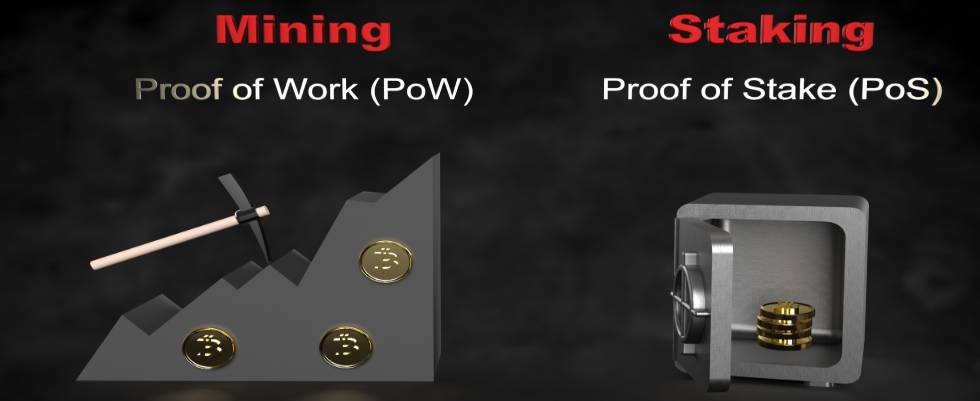In the realm of cryptocurrency, Proof of Work (PoW) and Proof of Stake (PoS) stand out as the two most prevalent consensus mechanisms, each with its unique approach to validating transactions and securing the network. Let’s demystify these concepts, exploring how they function and their implications for the future of digital currencies.
What is Proof of Work (PoW)?

The concept of PoW was first discussed in 1992 as a method of combatting junk emails. The idea only began to seep into the public consciousness in 2008, however, when Satoshi Nakomoto had the bright idea of implementing the algorithm to secure a digital payments network. And, thus, Bitcoin was born.
To validate a transaction on the Bitcoin network a computer (or node) needs to solve a computational puzzle. The solution to the puzzle is called a hash. The more hashing power a node has, the more likely it is to solve the puzzle and produce a bitcoin block.
To incentivize people to join the Bitcoin network (or any PoW crypto blockchain) miners earn fees from the transactions in each block plus a block reward in BTC. Mining is one of the alternative way to get a bitcoin instead of just buying Bitcoin with your own money. Every time a computational puzzle is solved, a new block is minted. A new puzzle is then created which must be solved in order to mint the next block.
The Bitcoin network uses difficulty adjustment to deter data manipulation. Higher difficulty means that it will take more computing powe
Originally conceptualized to combat spam emails, PoW gained prominence with Bitcoin’s inception, conceptualized by Satoshi Nakamoto. This consensus mechanism requires nodes to solve complex puzzles, thereby validating transactions and creating new blocks.
How Does Proof of Work Function?
- Nodes compete to solve mathematical puzzles, with the winning node minting the next block and receiving transaction fees and block rewards.
- The Bitcoin network adjusts the difficulty of these puzzles to maintain a consistent block creation time and ensure network security.
- PoW’s design inherently discourages malicious activity by making data manipulation economically unfeasible.
Despite its strengths in security and network resilience, PoW has drawn criticism for its substantial energy consumption and contribution to mining centralization. Discover more about Bitcoin and PoW on Coinmama.
What is Proof of Stake (PoS)?

Proof of stake
Introduced by Sunny King and Scott Nadal, PoS emerged as an energy-efficient alternative to PoW, focusing on transaction validation without the energy-intensive mining process.
How Does Proof of Stake Operate?
- Instead of mining, users ‘stake’ their cryptocurrency to gain the right to validate transactions and create new blocks.
- Validators are chosen based on the amount of crypto they stake and the duration of staking, incentivizing long-term investment in the network.
- PoS employs slashing mechanisms to penalize dishonest validators, further securing the network.
While PoS addresses energy concerns and promotes more eco-friendly crypto operations, it faces criticism for potentially favoring wealthier participants. Learn about the shift towards PoS with Ethereum’s transition on Coinmama.
Delegated Proof of Stake (DPoS): A Fairer System?
DPoS, an evolution of PoS, allows users to delegate their staking power to others, democratizing the validation process and providing opportunities for smaller stakeholders to participate in network governance.
Is DPoS the Solution to Centralization?
While DPoS offers more inclusivity, it still grapples with centralization risks, akin to PoW’s mining pools. However, its model promotes broader participation in the consensus process, potentially leading to more decentralized and agile network governance.
Comparing PoW and PoS: Which Is Superior?
Energy Consumption and Environmental Impact
- PoW’s extensive energy usage has sparked debate, especially when compared to the traditional banking system’s footprint.
- PoS offers a greener alternative, significantly reducing the energy required for transaction validation and network security.
Resistance to Manipulation and Centralization
- PoW networks, particularly Bitcoin, are robust against attacks due to the high costs of acquiring sufficient computational power.
- PoS, while less resource-intensive, could potentially allow wealthier participants to exert greater influence over the network.
Governance and Innovation
- PoW’s rigid structure can slow down protocol evolution, while PoS facilitates more dynamic governance, enabling quicker adoption of network upgrades and innovations.
Ultimately, the choice between PoW and PoS hinges on the priorities of a blockchain network, be it security, energy efficiency, or governance flexibility. As the crypto landscape evolves, the debate between these consensus mechanisms continues, shaping the future of digital currencies.
For those looking to dive into the world of crypto, Coinmama offers a user-friendly platform to buy Crypto, Ethereum, and other cryptocurrencies, empowering you to be part of this financial revolution.



